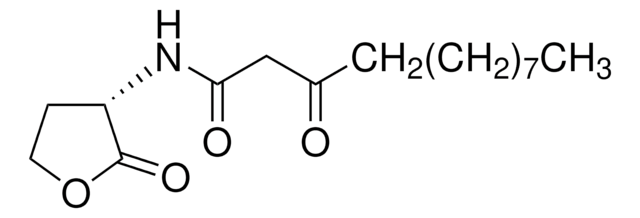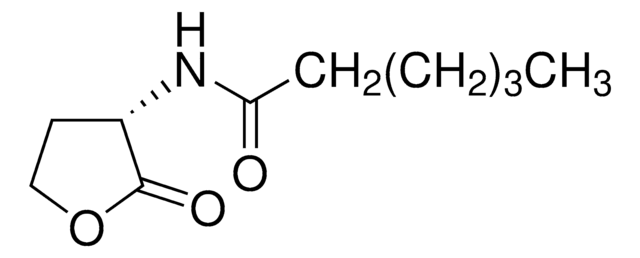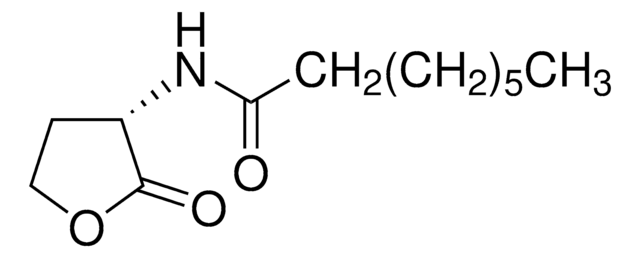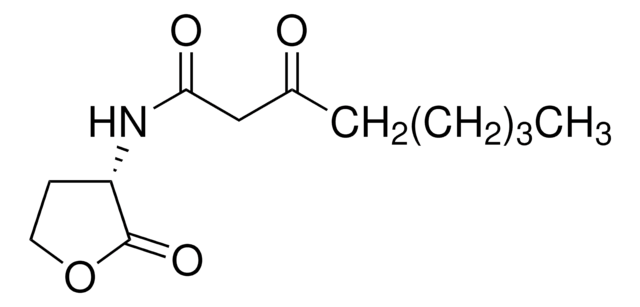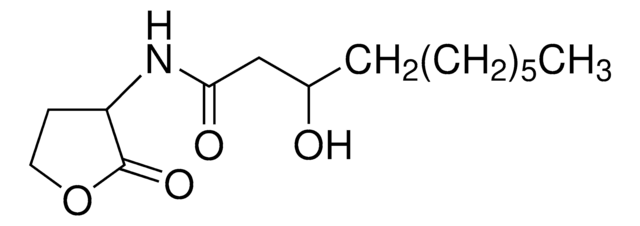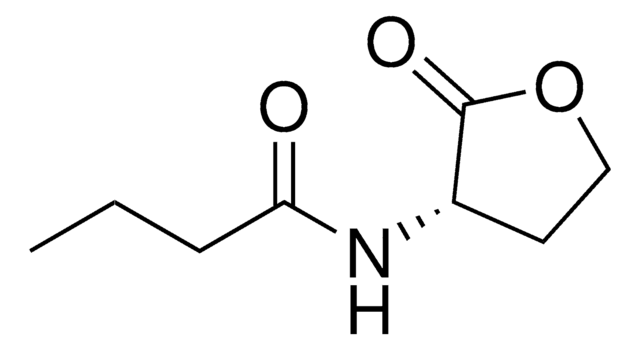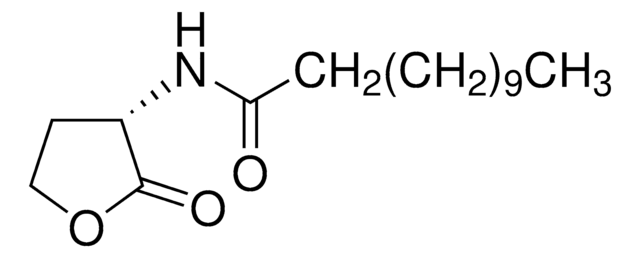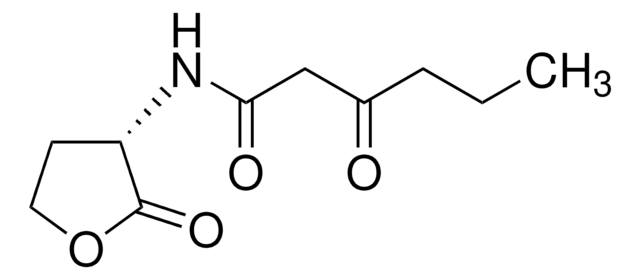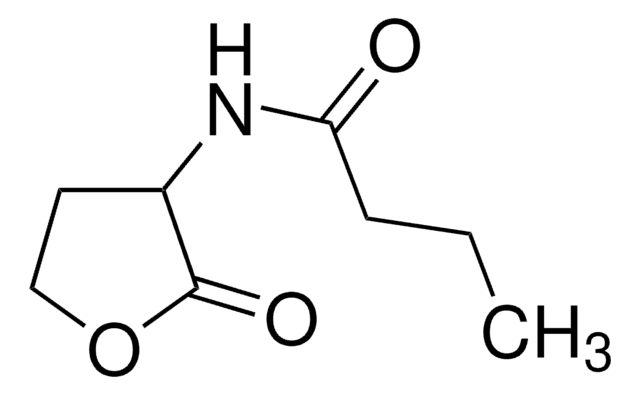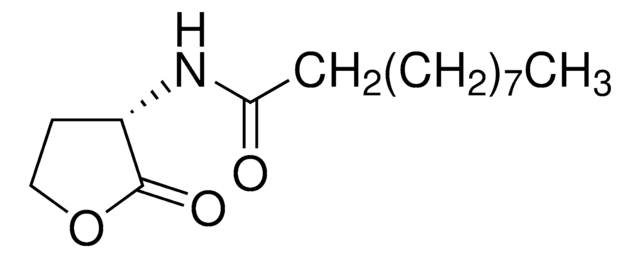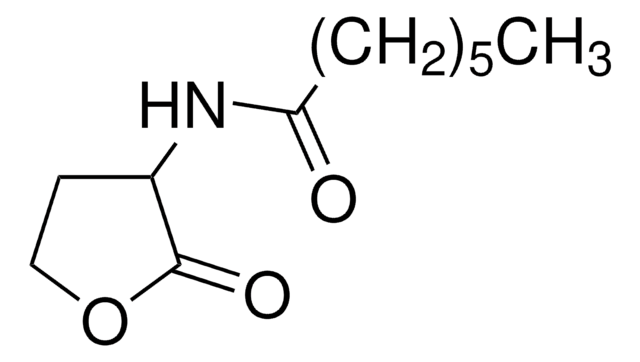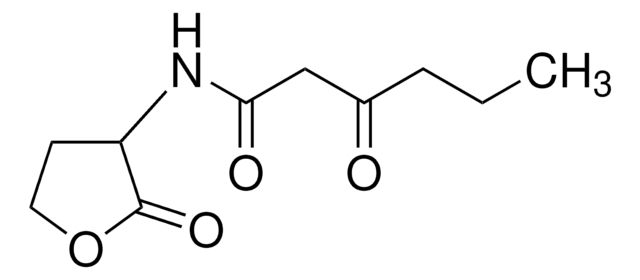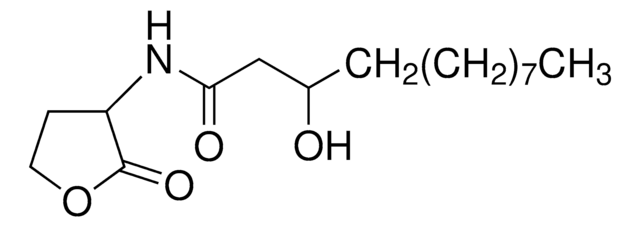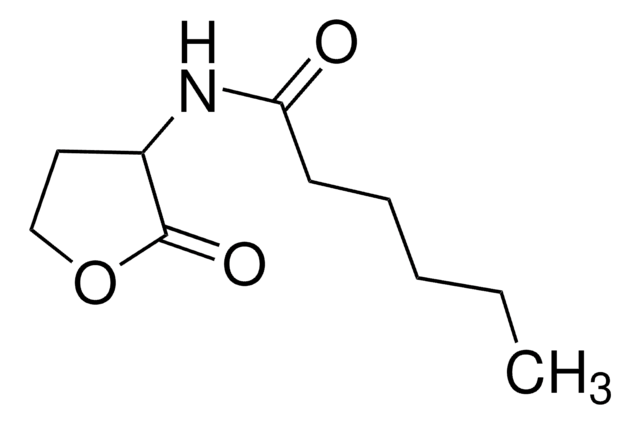Alle Fotos(1)
Wichtige Dokumente
O9264
N-(3-Oxotetradecanoyl)-L-Homoserinlacton
≥98% (TLC)
Anmeldenzur Ansicht organisationsspezifischer und vertraglich vereinbarter Preise
Alle Fotos(1)
About This Item
Empirische Formel (Hill-System):
C18H31NO4
Molekulargewicht:
325.44
MDL-Nummer:
UNSPSC-Code:
12352209
eCl@ss:
32160406
PubChem Substanz-ID:
NACRES:
NA.26
Empfohlene Produkte
Produktbezeichnung
N-(3-Oxotetradecanoyl)-L-Homoserinlacton,
Assay
≥98% (TLC)
Qualitätsniveau
Form
powder
Farbe
white
Anwendung(en)
cell analysis
Versandbedingung
wet ice
Lagertemp.
−20°C
SMILES String
CCCCCCCCCCCC(=O)CC(=O)N[C@H]1CCOC1=O
InChI
1S/C18H31NO4/c1-2-3-4-5-6-7-8-9-10-11-15(20)14-17(21)19-16-12-13-23-18(16)22/h16H,2-14H2,1H3,(H,19,21)/t16-/m0/s1
InChIKey
YQFJJDSGBAAUPW-INIZCTEOSA-N
Anwendung
N-(3-Oxotetradecanoyl)-L-Homoserin-Lacton (3-Oxo-C14-HSL), das zur Familie der Acyl-Hhomoserin-Lactone gehört, kann verwendet werden, um seinen Wirkungsmechanismus und seine Wirkungsspezifität als Signalmolekül, das an der Regulierung des bakteriellen Quorum Sensing beteiligt ist, zu bestimmen.
Biochem./physiol. Wirkung
Acylhomoserinlacton wird als Autoinduzierer des Quorum-Signalwegs durch Sinorhizobium meliloti, Yersinia enterocolitica und andere gramnegative Bakterien verwendet.
N-(3-Oxotetradecanoyl)-L-Homoserin-Lacton (3-oxo-C14-HSL) gehört zu einer Gruppe von Homoserin-Lactonen, die N-Octanoyl-Homoserin-Lacton (N-C8-HSL), N-(3-oxodecanoyl) Homoserin-L-Lacton (3-oxo-C10 HSL), N-(3-oxododecanoyl)Homoserin-L-Lacton (3-oxo-C12-HSL), N-(3-hydroxydecanoyl)-L-Homoserin-Lacton und N-(3-hydroxyoctanoyl)-L-Homoserin-Lacton umfassen, die an den Prozessen des bakteriellen Quorum Sensing beteiligt sind. Diese Homoserin-Lactone werden für die Untersuchung der Prozesse und Mechanismen des bakteriellen Quorum Sensing verwendet.
Lagerklassenschlüssel
11 - Combustible Solids
WGK
WGK 3
Flammpunkt (°F)
Not applicable
Flammpunkt (°C)
Not applicable
Persönliche Schutzausrüstung
Eyeshields, Gloves, type N95 (US)
Hier finden Sie alle aktuellen Versionen:
Besitzen Sie dieses Produkt bereits?
In der Dokumentenbibliothek finden Sie die Dokumentation zu den Produkten, die Sie kürzlich erworben haben.
Kunden haben sich ebenfalls angesehen
Rumana Rashid et al.
Microbes and environments, 26(2), 144-148 (2011-04-20)
N-Acylhomoserine lactones (AHLs) are used as quorum-sensing signaling molecules by many Gram-negative bacteria. Here, 413 bacterial strains were obtained from the roots of potato plants and screened for AHL-degrading bacteria using Chromobacterium violaceum reporter strains. Sixty one isolates degraded N-hexanoyl-L-homoserine
Bijay K Khajanchi et al.
Infection and immunity, 79(7), 2646-2657 (2011-05-04)
Aeromonas hydrophila leads to both intestinal and extraintestinal infections in animals and humans, and the underlying mechanisms leading to mortality are largely unknown. By using a septicemic mouse model of infection, we showed that animals challenged with A. hydrophila die
John F Teiber et al.
Methods in molecular biology (Clifton, N.J.), 692, 291-298 (2010-10-30)
Mammalian paraoxonases (PONs) are a unique, highly conserved family of calcium-dependent esterases consisting of PON1, PON2, and PON3. The PONs can hydrolyze the lactone ring of a range of N-acyl-L: -homoserine lactone (AHL) quorum sensing signaling molecules, rendering them inactive.
Manabu Horikawa et al.
Bioorganic & medicinal chemistry letters, 16(8), 2130-2133 (2006-02-08)
The synthesis of the analogs of N-3-oxododecanoyl-L-homoserine lactone (1) and their structure-activity relationship for the apoptotic induction in macrophages, P388D1 cells, are described. It was revealed that the position of the oxo group in the acyl side chain in addition
Mair E A Churchill et al.
Methods in molecular biology (Clifton, N.J.), 692, 159-171 (2010-10-30)
Quorum sensing plays a central role in regulating many community-derived symbiotic and pathogenic relationships of bacteria, and as such has attracted much attention in recent years. Acyl-homoserine lactones (AHLs) are important signaling molecules in the quorum sensing gene-regulatory processes found
Unser Team von Wissenschaftlern verfügt über Erfahrung in allen Forschungsbereichen einschließlich Life Science, Materialwissenschaften, chemischer Synthese, Chromatographie, Analytik und vielen mehr..
Setzen Sie sich mit dem technischen Dienst in Verbindung.